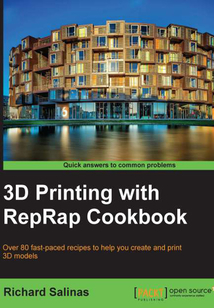舉報 

會員
3D Printing with RepRap Cookbook
最新章節:
Index
Asystematicguideconsistingofover100recipeswhichfocusonhelpingyouunderstandtheprocessof3DprintingusingRepRapmachines.Thebookaimsatprovidingprofessionalswithaseriesofworkingrecipestohelpmaketheirfuzzynotionsintoreal,saleableprojects/objectsusing3Dprintingtechnology.ThisbookisfornovicedesignersandartistswhoownaRepRap-based3Dprinter,havefundamentalknowledgeofitsworking,andwhodesiretogainbettermasteryoftheprintingprocess.Forthemoreexperienceduser,itwillprovideahandyvisualresource,withside-by-sidecomparisonsofthetwomostpopularslicers,SkeinforgeandSlic3r.Abasicunderstandingofdesigningandmodelingprinciplesandelementaryknowledgeofdigitalmodelingwouldbeaplus.
目錄(160章)
倒序
- coverpage
- 3D Printing with RepRap Cookbook
- Credits
- About the Author
- About the Reviewers
- www.PacktPub.com
- Support files eBooks discount offers and more
- Preface
- What this book covers
- Who this book is for
- What you need for this book
- Pronterface
- Repetier-Host
- Conventions
- Reader feedback
- Customer support
- Chapter 1. Getting Started with 3D Printing
- Introduction
- 3D scanning with a digital camera
- Processing a 3D scan with 123D Catch
- Viewing your scene with 123D Catch
- Stitching photos with 123D Catch
- Changing mesh resolutions with 123D Catch
- Cleaning up the model with 123D Catch
- Using the Autodesk 3D Print Utility
- Let's print!
- Slicing the models with Slic3r
- Slicing the models with Skeinforge
- Reviewing the print results
- Chapter 2. Optimizing the Printing Process
- Introduction
- Inspecting the model with Meshmixer
- Plane alignment with Meshmixer
- Scaling the model with Meshmixer
- Leveling the model with Meshmixer
- Removing scanning artifacts with Meshmixer
- Shaping the model with Meshmixer
- Let's print!
- Optimizing infill with Slic3r
- Chapter 3. Scanning and Printing with a Higher Resolution
- Introduction
- Setting up DAVID Laserscanner
- Calibrating DAVID Laserscanner
- Scanning with DAVID Laserscanner
- Viewing the model in MeshLab
- Cleaning the scans with MeshLab
- Aligning the scans with MeshLab
- Merging and remeshing the aligned scans in MeshLab
- Let's print!
- Tuning up the printer
- Using Skeinforge with a 0.5 mm nozzle
- Using Skeinforge with a 0.35 mm nozzle
- Using Skeinforge with a 0.25 mm nozzle
- Using Slic3r to print different resolutions
- Reviewing the print results
- Chapter 4. Modeling and Printing with Precision
- Introduction
- Warming up with SketchUp
- Using 3D tools from the Extension Warehouse
- Modeling with SketchUp
- Using plugin extensions with SketchUp
- Let's print!
- Calibrating the x y and z axes
- Controlling the flow rate in Skeinforge
- Adjusting the scale in Skeinforge
- Using Stretch in Skeinforge
- Controlling print warping
- Using brim with Slic3r
- Reviewing the print results
- Chapter 5. Manipulating Meshes and Bridges
- Introduction
- Exploring TopMod
- Using TopMod for remeshing
- Using MeshLab for remeshing
- Mesh decimation with MeshLab
- Wireframe modeling with TopMod
- Let's print!
- Cooling ABS and PLA with Skeinforge
- Cooling ABS and PLA with Slic3r
- Adjusting speed with Slic3r
- Bridging with Slic3r
- Adjusting speed with Skeinforge
- Bridging with Skeinforge
- Reviewing the print results
- Chapter 6. Making the Impossible
- Introduction
- Using extruding options in TopMod
- Using cutting options in TopMod
- Working with edges in TopMod
- Creating handles in TopMod
- Making a starfish in TopMod
- Creating support with Meshmixer
- Let's print!
- Creating support with Skeinforge
- Support options with Skeinforge
- Creating support with Slic3r
- Support options with Slic3r
- Reviewing our print results
- Chapter 7. Texture – the Good and the Bad
- Introduction
- Making textures with Meshmixer
- Making stencils with Paint.NET
- Stamping stencils with Meshmixer
- Making patterns with Meshmixer
- Making more patterns with Meshmixer
- Making textures with MeshLab
- Let's print!
- Adjusting the travel speed with Skeinforge
- Adjusting retraction with Skeinforge
- Adjusting Jitter with Skeinforge
- Adjusting the travel speed with Slic3r
- Adjusting retraction with Slic3r
- Randomizing the starting points with Slic3r
- Reviewing the print results
- Chapter 8. Troubleshooting Issues in 3D Modeling
- Introduction
- Using Repetier-Host for analysis
- Repairing mesh geometry issues
- Using SketchUp for editing meshes
- Using MeshLab for fixing normals
- Using MeshLab for cleaning meshes
- Creating a hollow model with MeshLab
- Creating a drain hole with Meshmixer
- Chapter 9. Troubleshooting Issues in 3D Printing
- Introduction
- Leveling the build platform
- Taking proper care of the build platform surface
- Troubleshooting issues with the heat bed
- Troubleshooting issues with the extruder
- Troubleshooting issues with the hot end
- Troubleshooting issues with the x y and z axes
- Troubleshooting issues with the motor system
- Appendix A. Understanding and Editing Firmware
- An Arduino IDE program
- Getting Windows to recognize the controller
- Getting the Arduino IDE to recognize the Sanguinololu
- Setting up the Arduino IDE for your controller
- Setting up the firmware in the Arduino IDE
- Comparing firmware versions with WinMerge
- Editing the firmware with the Arduino IDE
- Uploading the firmware to the controller
- Appendix B. Taking a Closer Look at G-code
- Generating G-code
- Viewing G-code
- Basic G-code commands
- Using the command line
- Appendix C. Filament Options for RepRap Printers
- Health considerations
- An ABS filament
- A PLA filament
- A PET filament
- A nylon filament
- A HIPS filament
- A TPE filament
- A wood filament
- A stone filament
- A ceramic filament
- A water-soluble PVA filament
- Storage of 3D printing filaments
- Index 更新時間:2021-07-16 11:31:18
推薦閱讀
- 快學Flash動畫百例
- 80x86/Pentium微型計算機原理及應用
- Photoshop CS3特效處理融會貫通
- 統計學習理論與方法:R語言版
- 工業機器人操作與編程
- Docker on Amazon Web Services
- R Machine Learning Projects
- MATLAB-Simulink系統仿真超級學習手冊
- 漢字錄入技能訓練
- 精通ROS機器人編程(原書第2版)
- Office 2010輕松入門
- fastText Quick Start Guide
- Practical Computer Vision
- 數據庫技術:Access 2003·計算機網絡技術
- iPhone Game Blueprints
- 實戰GAN:TensorFlow與Keras生成對抗網絡構建
- 中文版Flash CS6高手速成
- TensorFlow 2.0 Quick Start Guide
- Data Visualization with D3.js Cookbook
- 微機原理與接口技術
- C語言程序設計任務驅動式教程(第2版)(微課版)
- 機器人力觸覺感知技術
- 百煉成鋼:Excel函數高效技巧與黃金案例
- Hands-On Data Science with the Command Line
- 人本智造:工業5.0的核心使能技術
- CentOS System Administration Essentials
- Cassandra High Availability
- Machine Learning with scikit:learn Quick Start Guide
- 數據庫應用基礎:Visual FoxPro 6.0計算機網絡基礎
- 51單片機應用開發25例

